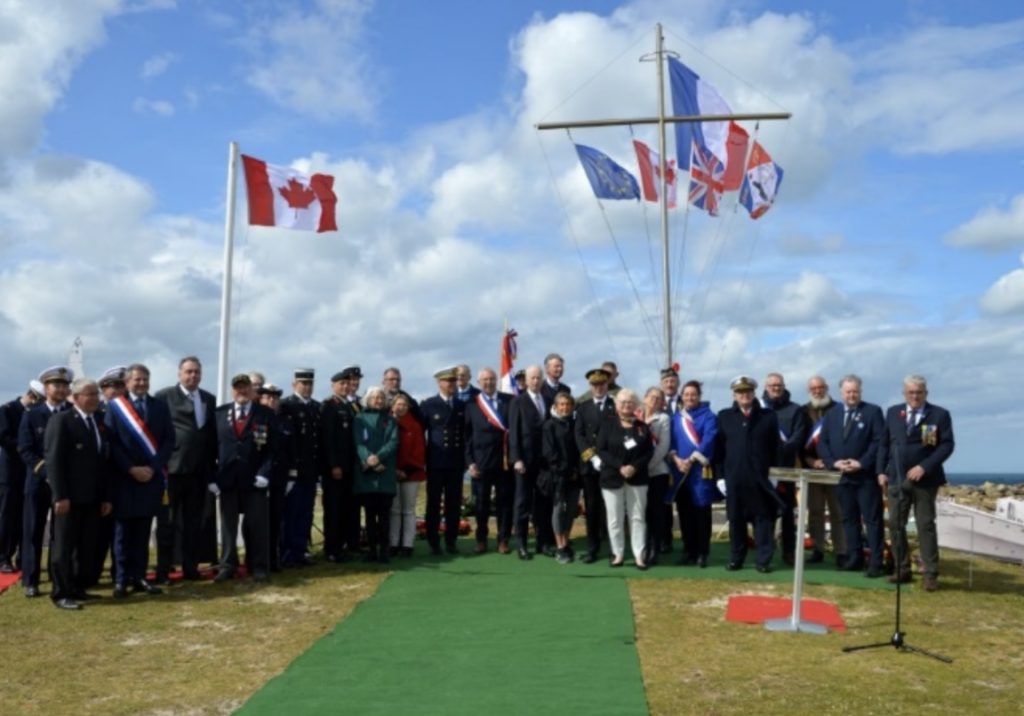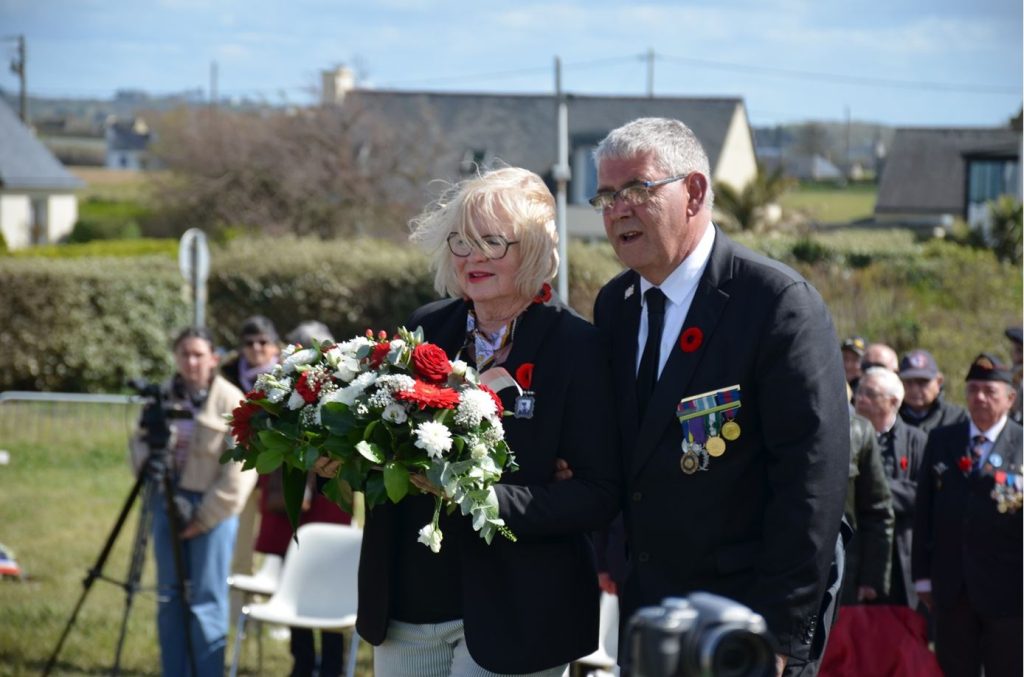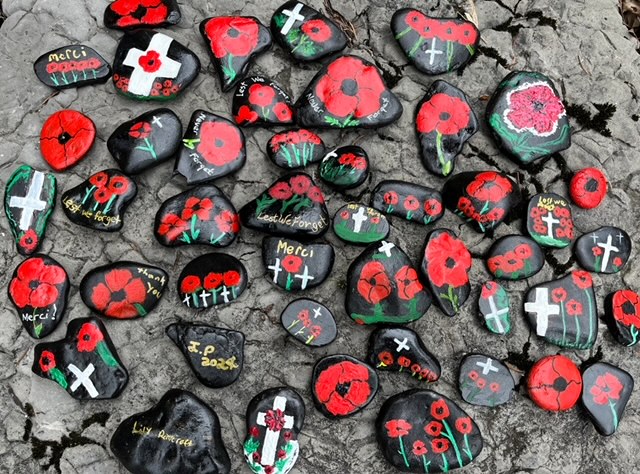
Families remember lost HMCS Athabaskan sailors 80 years after sinking
By Sherry Pringle

SUBMITTED
Eighty years have passed since the tragic loss of Canada’s Tribal Class Destroyer, HMCS Athabaskan, sunk off the coast of Brittany, France, with the loss of 128 lives.
She and her Tribal sister HMCS Haida, were sent on a mission on April 28, 1944, to accompany British minelayers, preparing the coastal waters of the Channel, in readiness for the Normandy Invasion. Haida and Athabaskan were the only support force that night. When the ships untied from Canada Buoy in Plymouth Harbour, Athabaskan was carrying a complement of 261 crew.
The mine layers had completed their mission and were heading home to England when in the pre-dawn hours of April 29, Athabaskan was struck by a torpedo from T24, an Elbing Class Destroyer, sinking her in 11 minutes. Haida gave chase to the two Elbings, T24 & T27. She ran T27 up onto the rocky coastline and returned to the disaster scene, only to discover Athabaskan had disappeared from the surface. The ocean was littered with flotsam and sailors adrift on the sea, lights bobbing from their helmets.
With dawn breaking, Central Command called Haida home for fear of retaliatory air strikes. After letting down her carly floats and rescuing 44 sailors and another six with her cutter, she turned homeward. Athabaskan’s 31-year -old Captain, Lieutenant Commander John H. Stubbs, waved Haida away, choosing to stay in the frigid sea with his men.
The Germans returned in daylight hours and rescued 83 crew, shipping them off to the prison camps of Milag and Marlag in Northern Germany. Ninety-one sailors washed ashore at nine different locations along Brittany’s coastline.
For decades, Athabaskan families have held their lost loved ones in their hearts. There were no bodies brought home, no gravesites on Canadian soil to weep over, but the grateful citizens of Brittany, France stepped up to honour and take care of our beloved lost sailors, buried on their soil.
In the ensuing hours, following the sinking, local townsfolk and fishermen pulled the bodies ashore and transported them by pony carts to their final resting places in nine local cemeteries.
The painful memories of that fateful pre-dawn day, a prelude to that of the D-Day conflict and victory, have never been forgotten by the families of 128 men and the 83 who suffered through the remainder of the war as prisoners of war. Although, the disaster is legendary in naval circles, and the bravery of young LCdr Stubbs tops the charts of Canadian heroes, the date remains largely unknown by Canadians, save the Friends of Haida. As a permanent floating museum in Hamilton, ON, the ship plays host to an annual ceremony every year, on the Sunday closest to April 29.
The French citizens of Brittany, however, certainly have not forgotten the sacrifice of so many young men. Every year, whether Canadians are present or not, they celebrate their honour and sacrifice for the sake of their freedom, not once but three times a year.
All 261 Athabaskan captain and crew have now “crossed the bar”. Their legacy lives on in the families and in the hearts of the French citizens of Brittany.
This past April 29, 2024, nine Canadian family and friends of Athabaskan’s crew gathered on French soil to join in the commemoration ceremonies for Athabaskan’s sacrifice. Collectively, we represented four Canadian families, that of 1st Lt. Ralph Lawrence, who was married less than two weeks, 21-year-old Irwin Amiro and 19-year-old Maurice Waitson, along with 23-year-old Herman Sulkers, taken as a POW. We may have only been four families, but we represented all Athabaskan families and all of Canada.
Organized by Jean-Luc Conchis and Jean-Louis Segers, the nine Canadians were joined by marine archaeologist Jacques Ouchakoff who discovered Athabaskan’s remains, Canadian Ambassador to France Stephane Dion and Defence Attaché Colonel Jason Galuga, British Ambassador to France John Sinclair Duncan, as well as Admirals, prefects, town mayors and French citizens, including school children.
Although we Canadians were there for only two full days of commemoration, covering four of the nine cemeteries where Athabaskans lie, the French planned to continue on to the remaining five cemeteries. Each and every Athabaskan buried on French soil was to be honoured.

SUBMITTED
We also visited the relatively new monument erected on a bluff, overlooking the sea, facing west to Canada, at Kerlouan. Cutout models of Haida and Athabaskan, along with T24, T27 and T29, lined the bluff, along with cutouts of sailors and soldiers.
Amid the pomp and ceremony of a red carpet, pipers, colour guard and whipping winds, we honoured the bravery and sacrifice of HMCS Athabaskan, the ship’s captain and crew. Speeches were delivered by Ambassador Dion, President Conchis and others. We Canadians presented a flag, which had been flown on HMCS Haida, and which had accompanied Athabaskan on her final mission, to President of the Athabaskan Association in France, Jean-Luc Conchis.
We Canadians were greeted by hugs and tears from hundreds of French citizens, who turned out to pay their respects in all four locations. Some had lived through the war. Although the disaster occurred five weeks prior to the Normandy Invasion and the liberation of France, the disaster is close to the hearts of the French.
Not all our Athabaskan loved ones returned, but they are in a good place — a place of respect and gratefulness. They are well cared for.
Thank you to the Bretons, for all you have done to honour the brave crew of HMCS Athabaskan. Thank you from our Athabaskan families. Thank you from Canada.
Sherry Pringle is the author of “All The Ship’s Men: HMCS Athabaskan’s Untold Stories” and a relative of Athabaskan G07 crewmember AB Maurice Waitson, who was lost at sea on April 29, 1944.






